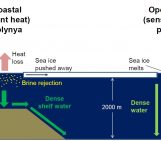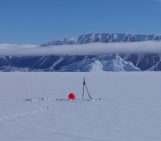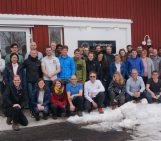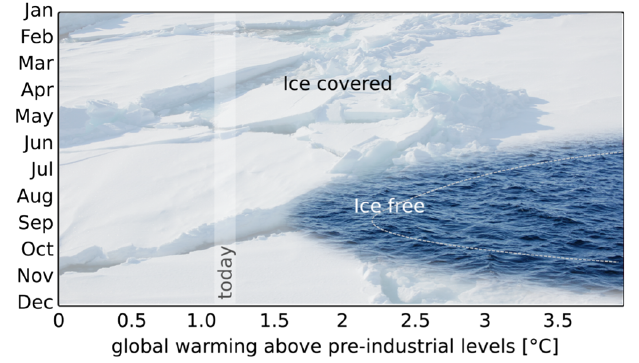
The illustration above shows a sketch of the evolution of Arctic sea ice for different levels of warming and the different months of the year, based on the simple extrapolation of observations. A new study, in which I was involved, uses the latest available global climate models and shows that the Arctic Ocean could become practically ice free at the end of the summer for the first time before 2050. This could happen even in a scenario where we drastically reduce our greenhouse gas emissions. This blog post is going to shed some light on the main outcomes of this study.
CMIP6 and SIMIP
The sixth phase of the Coupled Model Intercomparison Project, called ‘CMIP6’, is a major effort that encompasses all the global climate models that will feed the Sixth Assessment Report (AR6) of the Intergovernmental Panel on Climate Change (IPCC), which will be published in 2021-2022. Such a model intercomparison exercise is crucial in order to better understand the present and future climate changes arising from human activities and / or natural factors. Each of the previous CMIP projects allowed to considerably improve climate models.
The CMIP6 climate models take into account the three main components of the climate system at least, i.e. the atmosphere, ocean and sea ice. Sometimes, these models also consider the biogeochemical cycles, in which case they are called ‘Earth System models’. They are ‘global’ climate models, which means that they model processes for the whole Earth.
We included 40 different climate models in our study, or more precisely 40 different model configurations, as the same model is sometimes used two or three times with a different spatial resolution or an additional climate component. But for simplicity, we will talk about 40 different models for the rest of this post.
Compared to previous model intercomparisons, CMIP6 is a significant improvement over the previous intercomparison projects, from many different points of view. It includes more models and more greenhouse gas emission scenarios, it uses improved physics (e.g. clouds are better represented), a higher spatial resolution and more model outputs are available. One of the sub-CMIP6 projects, the Sea Ice Model Intercomparison Project (SIMIP), focuses on sea ice and brings together climate scientists working on this topic.
Our study summarizes the three main outcomes found by the SIMIP community:
- the large number of CMIP6 models leads to a wide range of values for the present Arctic sea-ice area and this spread is representative of the model uncertainty
- the CMIP6 models show a higher sensitivity of Arctic sea-ice area to CO2 emissions than previous models, in better agreement with observations
- Arctic sea ice could almost completely disappear in the summer for the first time before 2050.
Uncertainty in present Arctic sea ice
Our first key study result is that the performance of CMIP6 models in simulating Arctic sea-ice area is relatively similar to previous CMIP3 and CMIP5 models (for a precise definition of sea-ice area, I encourage you to have a look at this previous blog post). In particular, the spread in the model results remains large, with for example the Arctic sea-ice area varying between 3 and 10 million km2 in September (Fig. 2). Despite that, the multi-model mean sea-ice area is close to the observed value of 6 million km2 (value averaged over 1979-1998).

Figure 2: Mean September Arctic sea-ice area (average over 1979-1988) for CMIP3 (blue), CMIP5 (orange) and CMIP6 (green) models. Each dash represents one model and the crosses represent the multi-model means for each of the CMIP exercises. Observations are shown as a thick dashed black line and the plausible range around observations is represented by the two green dashed lines. Figure credit: Fig. 1b of SIMIP Community (2020).
The large spread in model results is also present when looking at Arctic sea-ice area in March, as well as Arctic sea-ice volume in both March and September. However, this model spread does not mean that the models are bad at simulating the climate. This rather means that the climate system is highly complex and this complexity is reflected by the wide range of processes simulated by the different climate models.
Sensitivity of Arctic sea ice to CO2 emissions
As we all know, Arctic sea-ice area and volume have strongly decreased during the past decades (see this post and this post). One of the main reasons for this sea-ice decline is the increased global temperature, caused by enhanced greenhouse gas emissions. For each ton of CO2 released into the atmosphere, the Arctic loses about 3 m2 of sea ice in September (see this post). This is what we call the sensitivity of Arctic sea ice to CO2 emissions.
In our study, we also looked at this sensitivity in all the available CMIP6 models and compared it to previous CMIP3 and CMIP5 models, as well as to observations. We found that the spread in this sensitivity is still large for CMIP6 but more models are within the ‘plausible’ range of observations compared to CMIP3 and CMIP5 (28 models out of 40, Fig. 3). Also, the CMIP6 multi-model mean is closer to the observed value, compared to the previous modeling efforts. In our analysis, we could not find out whether this better agreement with observations was due to a change in the model forcing or in the model physics, but this would be an interesting question to investigate further.
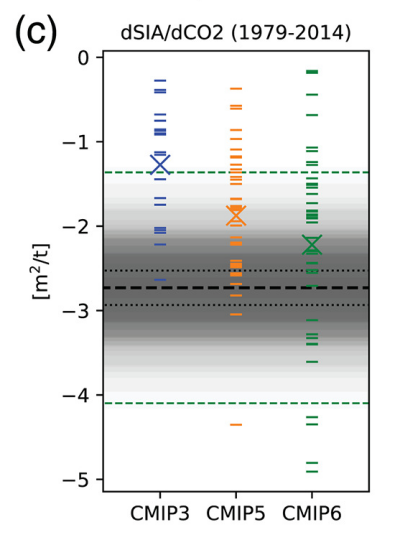
Figure 3: Sensitivity of September Arctic sea-ice area to CO2 emissions (average over 1979-2014) for CMIP3 (blue), CMIP5 (orange) and CMIP6 (green) models. Each dash represents one model and the crosses represent the multi-model means for each of the CMIP exercises. Observations are shown as a thick dashed black line and the plausible range around observations is represented by the two green dashed lines. Figure credit: Fig. 1c of SIMIP Community (2020).
Future projections of Arctic sea ice
Finally, we looked at model projections of Arctic sea-ice area using four different scenarios of greenhouse gas concentration (these scenarios are detailed here), varying from a very optimistic scenario in which CO2 emissions are drastically reduced to satisfy the Paris Agreement, to a very pessimistic one in which nothing is done to prevent global warming.
In particular, we looked at the first time the Arctic sea-ice area goes below 1 million km2 in September, the month during which the sea-ice area is minimum, for the available CMIP6 models. This threshold is often chosen to define ‘ice-free Arctic’ as it corresponds to an almost complete disappearance of Arctic sea ice.
Our finding related to future projections is that a majority of model simulations go below this threshold before 2050 (around 60-70% of all model simulations, Fig. 4), which does not leave us a lot of time… This finding remains valid if we only select the models that best represent both sea-ice area and sensitivity of sea-ice area to CO2 emissions. Also, what is interesting (and worrying) is that this result does not depend on the greenhouse gas emission scenario followed: the most optimistic scenarios (light blue and dark blue dots in Fig. 4) also show such an early sea-ice disappearance.
However, this does not mean that sea ice irremediably disappears in all model simulations. In some of them, it returns above the 1 million km2 threshold some years later, due to internal variability (see this post). So, in the end, the frequency of having ice-free conditions in the summer will highly depend on our actions today: if we drastically reduce our greenhouse gas emissions, we are more likely to see a lower number of ice-free years in the Arctic, than if we do not do anything (see this study for more information).
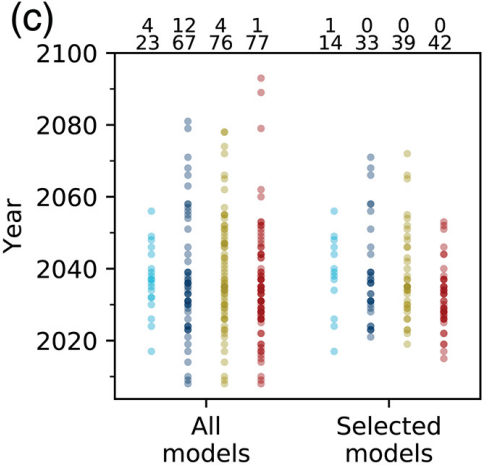
Figure 4: CMIP6 projections of the year when September Arctic sea-ice area drops below 1 million km2 (ice-free conditions). Each dot represents a model simulation. The four different colors show the four different scenarios, going from very optimistic (left, light blue) to very pessimistic (right, red). The left part of the diagram provides results from all CMIP6 models, while the right part shows the results from a selection of CMIP6 models that best capture the observed sea-ice area and observed sensitivity of sea-ice area to CO2 emissions. The numbers at the top indicate the number of model simulations that do not simulate ice-free conditions before 2100 (top row) and the total number of model simulations (bottom row). Figure credit: Fig. 3c of SIMIP Community (2020).
Impacts of Arctic sea-ice loss
Knowing how the Arctic sea ice will behave in the next years to decades is very important, not only for the Arctic environment itself, but also for the global climate. For example, the warmer Arctic Ocean and the addition of freshwater from the melting sea ice could lead to a slowdown of the ocean circulation in the North Atlantic Ocean (see this study for example). Also, the warmer temperatures in the Arctic could have an important effect on the atmosphere, and so climate, at mid-latitudes (see this review paper). But the global impacts of the disappearing sea ice are not totally understood at the moment and more research is urgently needed.
Further reading:
- SIMIP Community (2020). Arctic sea ice in CMIP6, Geophysical Research Letters, https://doi.org/10.1029/2019GL086749
- EGU Cryoblog Ice-hot news: The IPCC Special Report on the Oceans and the Cryosphere under Climate Change
- EGU Cryoblog Climate Change & Cryosphere – Why is the Arctic sea-ice cover retreating?
- Radio interview for Radio Télévision Suisse (RTS, 01/07/2020) in which I provided feedback on this study (13 min in French)
Edited by Giovanni Baccolo and Marie Cavitte
 David Docquier is a post-doctoral researcher at the Swedish Meteorological and Hydrological Institute (SMHI) in Sweden. His study focuses on the interactions between ocean heat transport and Arctic sea ice using the EC-Earth global climate model. His work is funded by the EU Horizon 2020 Marie Sklodowska-Curie OSeaIce project.
David Docquier is a post-doctoral researcher at the Swedish Meteorological and Hydrological Institute (SMHI) in Sweden. His study focuses on the interactions between ocean heat transport and Arctic sea ice using the EC-Earth global climate model. His work is funded by the EU Horizon 2020 Marie Sklodowska-Curie OSeaIce project.

